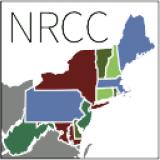Patchy Moderate Drought (D1) Returns to Southern New England and Southeastern New York
Key Points:
- Since the last Drought Status Update, moderate drought (D1) developed across southern portions of New York and Connecticut. Precipitation the following week helped alleviate drought in some of these areas, but D1 still remains in small areas of New York and Connecticut. D1 also developed in southern Rhode Island
- Widespread precipitation this weekend should stave off additional degradations. Local conditions should continue to be monitored.
- Abnormally Dry conditions (D0) still extend from the southeast corner of New Hampshire through southern New England.
- These local areas of abnormal dryness and drought are part of a broader area that extends into the Mid-Atlantic states where spring wildfire activity has been brisk (New Jersey).
- Seasonal snowfall totals continue to be below normal across the majority of the region. While less snowy winters can reduce the risk of spring flooding, they have, at times, also been a precursor of summer and fall droughts in the region.
Current U.S. Drought Monitor map for the Northeast Drought Early Warning System (DEWS) with data valid for April 25, 2023. The U.S. Drought Monitor is updated each Thursday to show the location and intensity of drought across the country.
According to the latest U.S. Drought Monitor:
- 11.61% of the Northeast is experiencing abnormally dry (D0) conditions
- 0.76% of the Northeast is in moderate drought (D1)
U.S. Drought Monitor Categories
Abnormally Dry (D0)
Abnormally Dry (D0) indicates a region that is going into or coming out of drought. View typical impacts by state.
Moderate Drought (D1)
Moderate Drought (D1) is the first of four drought categories (D1–D4), according to the U.S. Drought Monitor. View typical impacts by state.
Severe Drought (D2)
Severe Drought (D2) is the second of four drought categories (D1–D4), according to the U.S. Drought Monitor. View typical impacts by state.
Extreme Drought (D3)
Extreme Drought (D3) is the third of four drought categories (D1–D4), according to the U.S. Drought Monitor. View typical impacts by state.
Exceptional Drought (D4)
Exceptional Drought (D4) is the most intense drought category, according to the U.S. Drought Monitor. View typical impacts by state.
Current U.S. Drought Monitor map for the Northeast Drought Early Warning System (DEWS) with data valid for April 25, 2023. The U.S. Drought Monitor is updated each Thursday to show the location and intensity of drought across the country.
According to the latest U.S. Drought Monitor:
- 11.61% of the Northeast is experiencing abnormally dry (D0) conditions
- 0.76% of the Northeast is in moderate drought (D1)
The U.S. Drought Monitor map is updated weekly on Thursday mornings, with data valid through the previous Tuesday at 7 a.m. Eastern.
Current Conditions
Animation: U.S. Drought Monitor Change from February 28–April 25
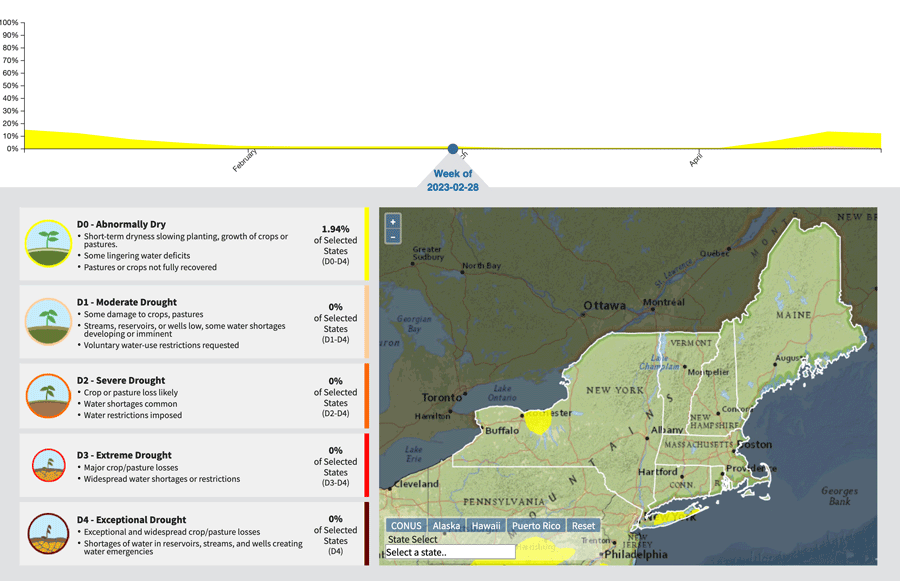
Accumulated Precipitation Departure from Normal
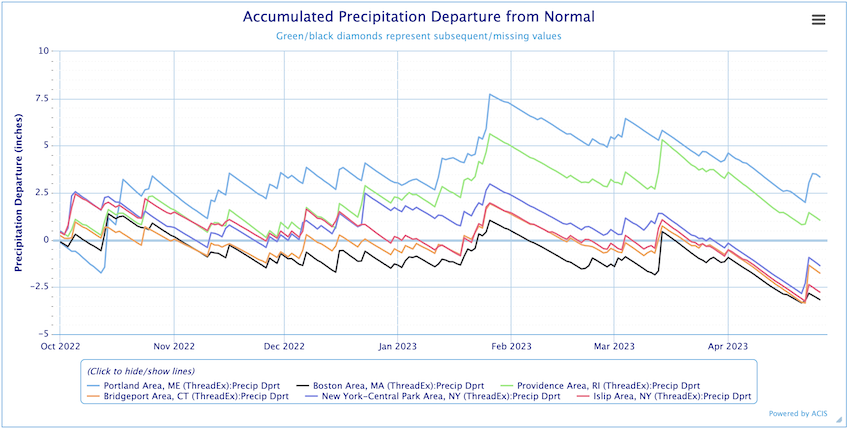
Water Year 2023 Snowfall Departure (Inches)
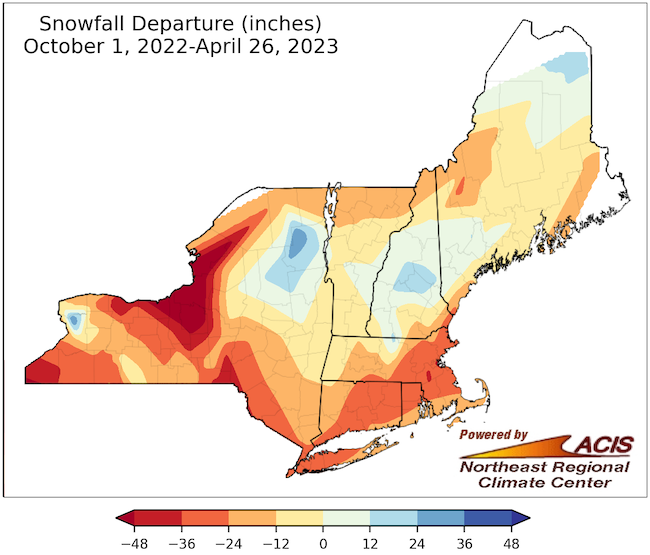
Accumulated Snowfall Departure from Normal
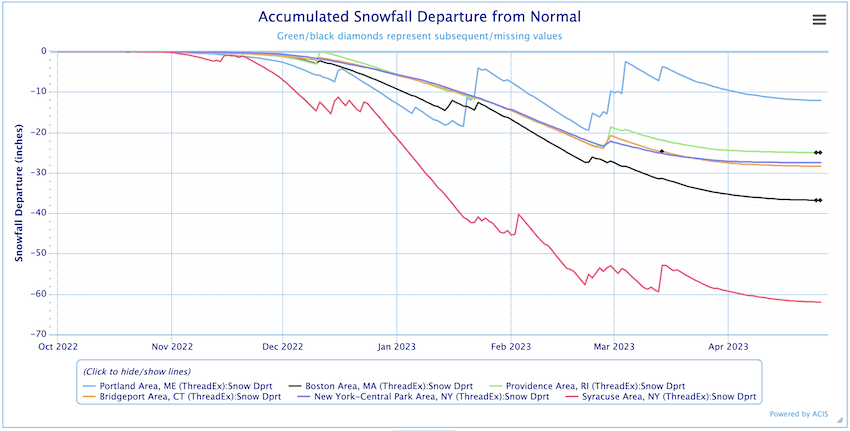
State-Reported Conditions and Impacts
Connecticut
- Connecticut Drought Information Center
- Impacts:
- April 14, 2023: The Bulletin – Brush Fires In Eastern Connecticut
- April 11, 2023: New Haven Register – Red Flag Warnings
Maine
- Maine Drought Task Force
- Impacts:
- April 19, 2023: Bangor Daily News – Good Start To The Growing Season
Massachusetts
- Massachusetts Drought Management Task Force
- Impacts:
- April 21, 2023: WBUR – Silvopasture Helps With Drought
- April 18, 2023: Daily Times Chronicle – Winchester Water And Sewer Rate Hikes Related To Drought
- April 14, 2023: The Shoestring – A Big Red Flag
- April 5, 2023: HomeNewsHere.com – Water Infrastructure Project Funding
New Hampshire
- New Hampshire Department of Environmental Services: Drought
- Impacts:
- April 19, 2023: Conway Daily Sun – Managing Your Backyard Habitat
- April 11, 2023: Public Radio NHPR – Fire Weather Conditions
New York
- New York State Department of Environmental Conservation (DEC): Drought
- Impacts:
- April 20, 2023: Genesee Valley PennySaver – Water Conservation
- April 18, 2023: Department of Environmental Conservation – Prescribed and Wildfires
- April 9, 2023: Westside News – Grants Help Farmers With Resiliency
- April 4, 2023: New York State Department of Environmental Conservation – Fire Efforts in Albany and Suffolk Counties
Rhode Island
- Rhode Island Water Resources Board: Drought Management Program
- Impacts:
- April 18, 2023: WPRI-12 – DEM: Exeter brush fire was RI’s largest since 1942 | WPRI.com
- April 13, 2023: The Providence Journal – West Greenwich wildfire burns 200 acres
Vermont
- Vermont Agency of Natural Resources, Department of Environmental Conservation: Drought and Other Hazards
- Impacts:
- April 5, 2023: Caledonian Record – Water Infrastructure Improvements Hedge Against Drought Vulnerability
Northeast
Volunteers are needed to measure precipitation! CoCoRaHS (the Community Collaborative Rain, Hail, and Snow Network) is a non-profit, community-based network of volunteer weather observers of all ages and backgrounds who measure and report precipitation. These data help improve the accuracy of weather forecasts, contribute to real-time drought and flood monitoring, are used in research applications, and so much more. Ready to help? Go to www.cocorahs.org and click the “Join CoCoRaHS” button in the upper right corner.
Find additional impacts through the National Drought Mitigation Center’s Drought Impact Reporter.
Visit the new Drought.gov state pages for additional maps and resources. Or, find local drought information by address, city or zip code on Drought.gov.
Outlooks
8–14 Day Temperature and Precipitation Outlooks
For May 4–10, below-normal temperatures will be helpful in terms of holding off evapotranspiration across the region for the next two weeks. Expected near-normal precipitation across the region may pause the drying trend for the next two weeks.
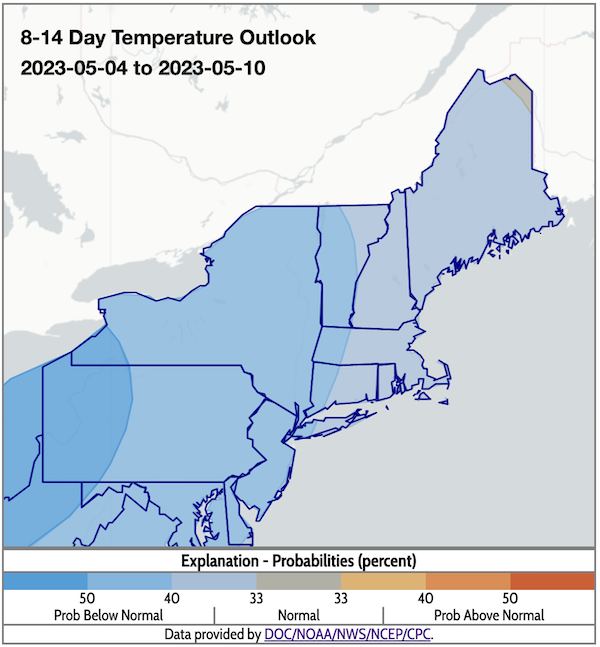
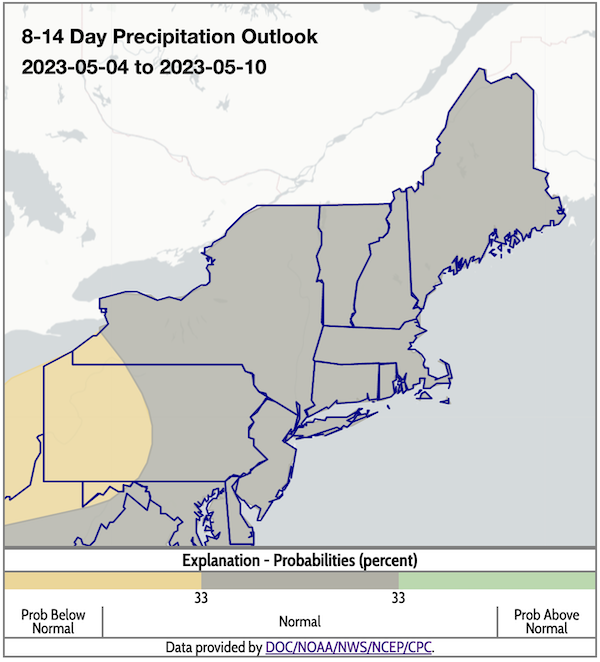
Week 3–4 Temperature and Precipitation Outlooks
Outlooks for May 6–19 show increased chances for above-normal temperatures for Maine, Rhode Island, eastern New Hampshire and Massachusetts. The rest of the region has equal chances for seasonal temperatures and this will be helpful with limiting drought potential for most of Connecticut and New York.
There are equal chances for below-normal or above-normal precipitation, across the region, during this period. Adequate precipitation for the start of the growing season is in question.
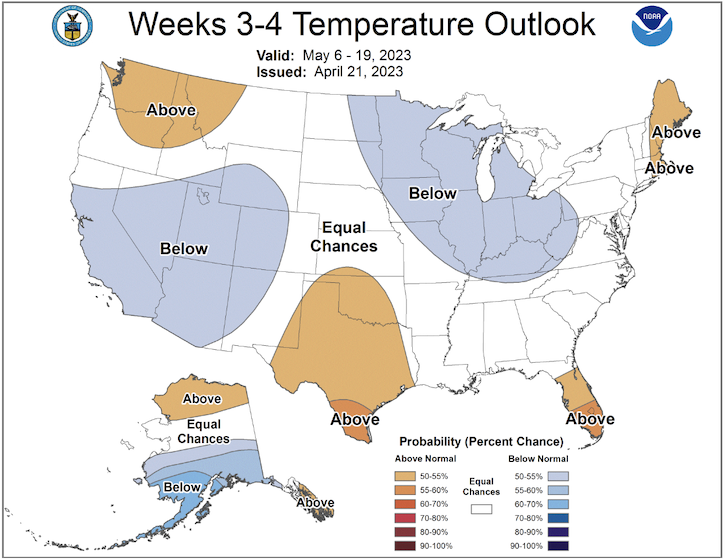
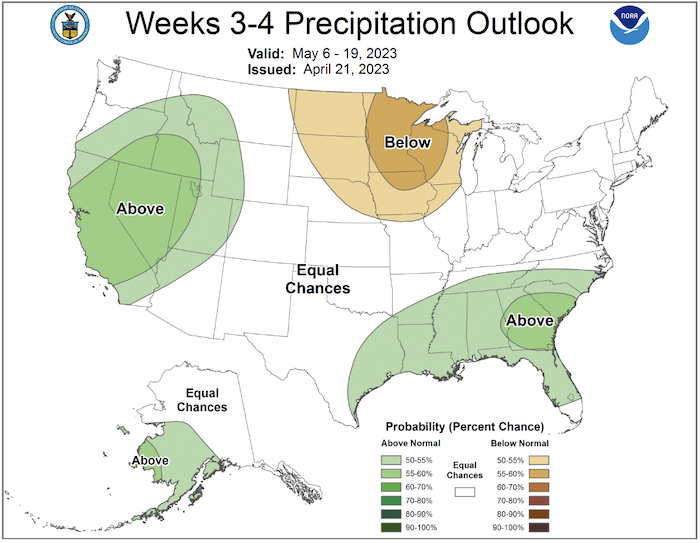
U.S. Seasonal Drought Outlook: April 20–July 31, 2023
The seasonal drought outlook is encouraging for the Northeast DEWS, with indications for improvements in the areas that are dry this week. This outlook runs through the end of July, when we begin to experience our warmest temperatures and drought concerns typically return with increased water demands. Combined with the awareness that we have just experienced winter season snowfall deficits in central New York and southern New England, the next seasonal outlook updates should be watched closely.
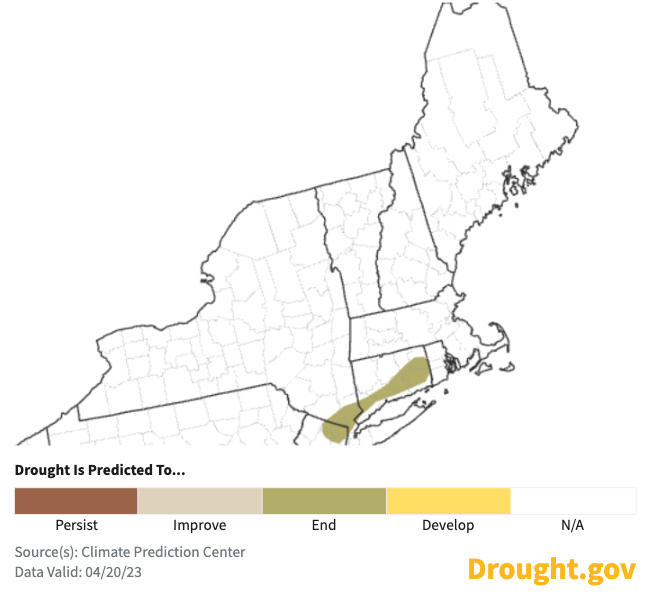
Special Announcement
NIDIS Launches Improved and Expanded State Pages
Just in time to monitor changing conditions in the spring and summer months, the U.S. Drought Portal now offers new and improved state pages. The NIDIS team wishes to thank all those who have assisted with the updated content and provided additional suggestions for improvements and new datasets.
Please check out your new state pages and share your feedback for further enhancements:
What We Are Watching
- Mid-Atlantic conditions:
- April 19, 2023: Asbury Park Press – New Jersey Wildfires
- April 19, 2023: New Jersey Monitor – Dry Winter Leads To A Busy WIldfire Season
- April 5, 2023: WHYY – Threats To Philly’s Drinking Water
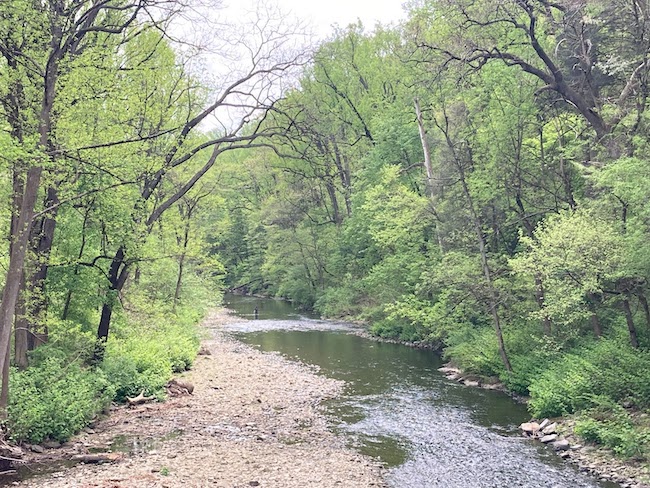
- USDA National Agricultural Statistics Service (NASS) Crop Progress and Condition Progress Reports for New York and New England. Issued April 24.
- New Jersey Forest Fire Service
- Extreme Heat in New York State Webinars
- Recent research:
- Opinion article in Trends in Microbiology: Microbial drought resistance may destablize soil carbon.
- Research article in Earth, Atmospheric, and Planetary Sciences: Twenty-first century hydroclimate: A continually changing baseline, with more frequent extremes.
- Research article in the Journal of American Water Resources Association: Drivers of future streamflow changes in watersheds across the Northeastern United States.
Featured Resources
- Drought newsletters:
- Dry Times is the National Integrated Drought Information System's national bi-weekly email newsletter. Get caught up on timely drought news, research, and events.
- Dry Horizons is a monthly publication from the University of Nebraska’s National Drought Mitigation Center (NDMC).
- Cybersecurity and Infrastructure Security Agency (CISA) Drought and Infrastructure: A Planning Guide. Or, read a 1-page overview.
- In case you missed it: 2022 Drought Remembrance - from the USGS Report
- Register for the National Coordinated Soil Moisture Monitoring Network’s next quarterly webinar on May 25, 2023: USDA Perspectives on Monitoring and Assessing Drought Impacts and Fire Risk.
- The 2023 National Soil Moisture Workshop will be held on August 14–17, 2023 in Beltsville, MD. Register and learn more.
Additional Resources
- Look back at previous Northeast DEWS Drought Status Updates
- Your local National Weather Service office
- NOAA Regional Climate Services Monthly Webinar Series (next webinar is on May 25)
- USDA Northeast Climate Hub
- USGS New England and New York Water Science Centers
Contacts for More Information
Sylvia Reeves
Regional Drought Information Coordinator (Northeast DEWS)
NOAA/CIRES/National Integrated Drought Information System (NIDIS)
Email: sylvia.reeves@noaa.gov
Ellen L. Mecray
Regional Climate Services Director, Eastern Region
NOAA/NESDIS/National Centers for Environmental Information
Email: Ellen.L.Mecray@noaa.gov
Prepared By
Sylvia Reeves
NOAA/National Integrated Drought Information System (NIDIS), CIRES
Samantha Borisoff, Jessica Spaccio, Keith Eggleston, Art DeGaetano, Natalie Umphlett
Northeast Regional Climate Center
Ellen Mecray
Regional Climate Services Director, Eastern Region, NOAA
Gardner Bent
USGS New England Water Science Center
In partnership with National Weather Service Offices of the Northeast and State Climate Offices of the Northeast.
This drought status update is issued in partnership between the National Oceanic and Atmospheric Administration (NOAA), U.S. Geological Survey, and the U.S. Department of Agriculture (USDA) to communicate concern for drought expansion and intensification within the Northeast U.S. based on recent conditions and the forecasts and outlooks. NIDIS and its partners will issue future drought status updates as conditions evolve.



